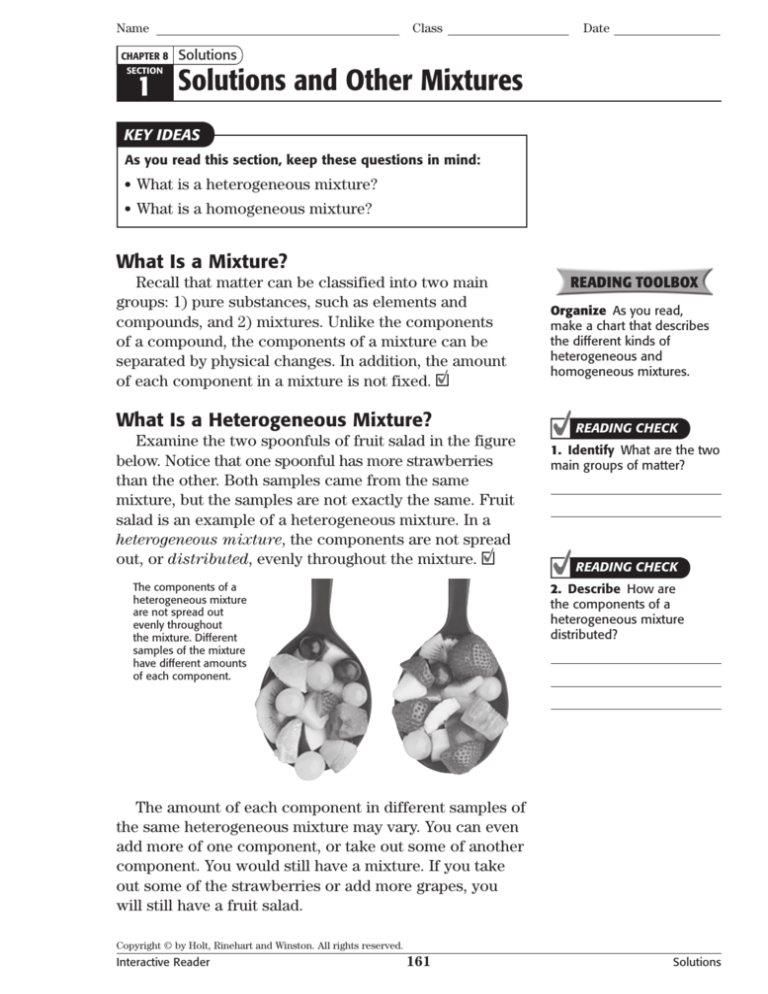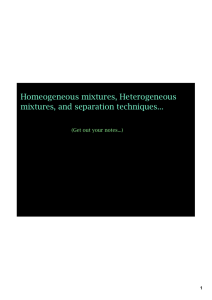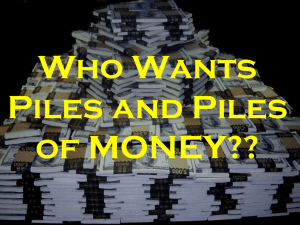
Name
CHAPTER 8
Class
Date
Solutions
SECTION
1 Solutions and Other Mixtures
KEY IDEAS
As you read this section, keep these questions in mind:
• What is a heterogeneous mixture?
• What is a homogeneous mixture?
What Is a Mixture?
Recall that matter can be classified into two main
groups: 1) pure substances, such as elements and
compounds, and 2) mixtures. Unlike the components
of a compound, the components of a mixture can be
separated by physical changes. In addition, the amount
of each component in a mixture is not fixed.
What Is a Heterogeneous Mixture?
Examine the two spoonfuls of fruit salad in the figure
below. Notice that one spoonful has more strawberries
than the other. Both samples came from the same
mixture, but the samples are not exactly the same. Fruit
salad is an example of a heterogeneous mixture. In a
heterogeneous mixture, the components are not spread
out, or distributed, evenly throughout the mixture.
The components of a
heterogeneous mixture
are not spread out
evenly throughout
the mixture. Different
samples of the mixture
have different amounts
of each component.
READING TOOLBOX
Organize As you read,
make a chart that describes
the different kinds of
heterogeneous and
homogeneous mixtures.
READING CHECK
1. Identify What are the two
main groups of matter?
READING CHECK
2. Describe How are
the components of a
heterogeneous mixture
distributed?
The amount of each component in different samples of
the same heterogeneous mixture may vary. You can even
add more of one component, or take out some of another
component. You would still have a mixture. If you take
out some of the strawberries or add more grapes, you
will still have a fruit salad.
Copyright © by Holt, Rinehart and Winston. All rights reserved.
Interactive Reader
161
Solutions
Name
Class
SECTION 1
Date
Solutions and Other Mixtures continued
SUSPENSIONS
Have you ever forgotten to shake the orange juice
carton? When you poured yourself a glass of orange juice,
it was probably watery. Orange juice is a heterogeneous
mixture. Shaking the mixture mixes the components of
the orange juice. However, eventually the mixture will
settle again into layers.
Orange juice is an example of a suspension. In a
suspension, the components that make up the mixture
may seem to be distributed almost evenly. However,
when the mixture is allowed to sit, one component settles
to the bottom. When orange juice sits for a while, the
pulp settles to the bottom of the container.
Right after you shake the
juice, the pulp is spread
throughout the mixture.
LOOKING CLOSER
3. Explain What happens to
the particles in a suspension
over time?
SPIRSOLSA
FIRSTPASS
READING
CHECK
3TEVE4OOLE
4. Explain Why is it
generally easy to filter out
particles in suspension?
Over time, the pulp
settles out of the mixture,
and two layers form.
Particles in a suspension are large enough to be
filtered out of the mixture. For example, to remove the
pulp from orange juice, you can pour the juice through a
filter of porous paper. This filter will catch the pulp but
will let the juice pass through.
Suspensions
Particles are relatively large.
Particles settle out or can be filtered.
Copyright © by Holt, Rinehart and Winston. All rights reserved.
Interactive SPIRSOLSA
Reader
162
Solutions
FIRSTPASS
3TEVE4OOLE
161-168_SP_C08_SOL_S01.indd 162
4/5/07 1:03:06 PM
Name
Class
SECTION 1
Date
Solutions and Other Mixtures continued
LIQUIDS IN SUSPENSION
Many suspensions, such as orange juice, are a mixture
of a liquid and a solid. However, some mixtures are made
up of two liquids. For example, you can combine oil,
vinegar, and spices to make salad dressing. If you shake
the ingredients, they will mix. However, if the dressing
sits for a while, the liquids will separate into layers.
Why? Oil and vinegar are immiscible. Liquids that are
immiscible do not mix or do not stay mixed.
READING CHECK
5. Define What are
immiscible liquids?
Many salad dressings are made
of oil and vinegar, which form a
suspension when shaken. Oil is
less dense than vinegar. When
the salad dressing sits for a
while, the oil rises and floats
on top of the vinegar.
EHHDBG@<EHL>K
6. Explain Why does the oil
rise above the vinegar?
COLLOIDS
Colloids are another type of heterogeneous mixture.
Like a suspension, a colloid has particles dispersed
throughout the mixture. However, the particles of a
colloid are smaller than the particles of a suspension.
The particles of colloids are so small that they can
pass through most filters and remain spread throughout
the mixture.
Latex paint is an example of a colloid. The color in
latex paint comes from particles of colored pigments
in water. Gelatin, egg whites, and blood plasma are all
examples of colloids. Whipped cream is a colloid made
by dispersing gas in a liquid. Fog is a colloid of water
droplets in air. Smoke is a colloid of small solid particles
in air.
8g^i^XVa I]^c`^c\
7. Compare What is the
main difference between a
suspension and a colloid?
Colloids
Particles are relatively small.
Particles cannot be filtered easily.
Copyright © by Holt, Rinehart and Winston. All rights reserved.
Interactive Reader
163
Solutions
Name
SECTION 1
Class
Date
Solutions and Other Mixtures continued
The liquid in the jar on
the right is a colloid. A
colloid may look clear,
but the particles may be
large enough to scatter
light. This scattering
of light is called the
Tyndall effect.
EHHDBG@<EHL>K
8. Describe What is the
Tyndall effect?
EMULSIONS
READING CHECK
An emulsion is a colloid made of liquids that are
generally immiscible. Mayonnaise is made of tiny
droplets of oil suspended in vinegar. Unlike the oil
and vinegar of salad dressing, the oil and vinegar in
mayonnaise stay mixed because of egg yolks. Egg
yolks act as an emulsifier. An emulsifier coats one
type of particles in the mixture so that they cannot join
to form a separate layer.
9. Explain How is an
emulsion different from
other colloids?
Like other colloids, an emulsion, such as cream, has particles
so small that the mixture looks like a pure substance. However, cream is a mixture of fats, proteins, and carbohydrates
dispersed in water. Proteins act as emulsifiers to coat the
droplets of fats and keep them dispersed.
Emulsions
An emulsion is a colloid made of
immiscible liquids.
Emulsifiers keep layers from
separating.
Copyright © by Holt, Rinehart and Winston. All rights reserved.
Interactive Reader
164
Solutions
Name
SECTION 1
Class
Date
Solutions and Other Mixtures continued
What Is a Homogeneous Mixture?
In a homogeneous mixture, the particles are dispersed
evenly throughout. In other words, a homogeneous
mixture is uniform. A sample from one part of a
homogeneous mixture is the same as any other sample
of the mixture. A homogeneous mixture looks uniform
even under a microscope.
If you stir a small amount of salt into water, the mixture
will look like pure water. Every part of the mixture has
the same relative amounts of salt and water particles. Like
any mixture, a mixture of salt and water can be separated
physically into its components. The components of a
mixture also keep their separate identities. Thus, you can
separate the salt from the mixture by evaporating the water.
READING CHECK
10. Describe How are
the components of a
homogeneous mixture
distributed?
EHHDBG@<EHL>K
11. Label Use
homogeneous mixture
and heterogeneous mixture
to label the diagrams.
SOLUTIONS
Solutions are homogeneous mixtures. A solution is a
homogenous mixture in which one or more components
dissolves in another. For examples, if you stir salt into
water, the salt dissolves in the water and seems to
disappear. What happens to the salt when it dissolves?
When a substance dissolves, it separates into the
smallest particles that make up the substance. These
particles may be atoms, ions, or molecules. For example,
in water, salt separates into Na+ and Cl− ions. In this
solution, salt is called the solute. A solute is the
substance that dissolves. In a saltwater solution,
water is the solvent. A solvent is the substance
in which the solute dissolves. Together, a solute
and solvent make up a solution.
READING CHECK
12. Describe What
happens to a substance
when it dissolves?
Copyright © by Holt, Rinehart and Winston. All rights reserved.
Interactive Reader
165
Solutions
Name
SECTION 1
Class
Date
Solutions and Other Mixtures continued
Water is a pure substance.
EHHDBG@<EHL>K
13. Identify Into what small
particles does salt separate
when it dissolves?
#HLORIDEION#L
7ATER
3ODIUMION.A
14. Apply Concepts What
kind of mixture is the gravel
at the bottom of the fish
tank?
Saltwater is a homogeneous
mixture. The water molecules,
sodium ions, and chloride
ions are distributed evenly
throughout the mixture.
Solutions
One substance dissolves in another.
Solute separates into atoms, ions,
or molecules when it dissolves.
SOLUTIONS OF LIQUIDS
READING CHECK
A solution may be made up of liquids. Two or more
liquids that mix easily and stay mixed are miscible. For
example, water mixes with isopropanol to form a
solution called rubbing alcohol. Water and isopropanol
are miscible, so they stay mixed. You can use rubbing
alcohol to disinfect cuts and scrapes.
15. Define What does
miscible mean?
Window cleaner, rubbing
alcohol, and gasoline are
all mixtures of liquids
Copyright © by Holt, Rinehart and Winston. All rights reserved.
Interactive Reader
166
Solutions
Name
Class
SECTION 1
Date
Solutions and Other Mixtures continued
OTHER KINDS OF SOLUTIONS
Water is not the only liquid that can be a solvent. For
example, gasoline is a homogeneous mixture of liquids
that contains no water. Nail polish remover is another
solution that contains no water.
Other states of matter can also form solutions. Gases
can dissolve in liquids, and solids can dissolve in solids.
For example, many carbonated drinks are solutions of a
gas (carbon dioxide), a liquid (water), and a solid (sugar).
8g^i^XVa I]^c`^c\
16. Apply Concepts What
states of matter are present
in a seawater solution? Give
examples of each state.
ALLOYS
An alloy is a homogeneous mixture that is made up
of two or more metals. Liquid metals are mixed together,
and a solid solution of metals forms when the mixture
cools.
Alloys are important because they have properties that
the individual metals do not have. For example, copper is
very soft and bends easily. Copper could not be used to
make a sturdy musical instrument. However, when zinc
is dissolved in copper, the brass that forms is harder than
copper, but bends more easily than zinc.
READING CHECK
17. Explain Why are alloys
sometimes more useful than
pure metals?
Some solutions are made of two or more metals. For example, brass is a
solution of zinc metal dissolved in copper.
Alloys
An alloy is one or more metals
dissolved in another.
Properties differ from those of the
individual metals.
Copyright © by Holt, Rinehart and Winston. All rights reserved.
Interactive Reader
167
Solutions
Name
Class
Date
Section 1 Review
SECTION VOCABULARY
alloy a solid or liquid mixture of two or more
metals
colloid a mixture consisting of tiny particles that
are intermediate in size between those in solutions and those in suspensions and that are
suspended in a liquid, solid, or gas
emulsion any mixture of two or more immiscible liquids in which one liquid is dispersed in
the other
solute in a solution, the substance that dissolves
in the solvent
solution a homogenous mixture throughout
which two or more substances are uniformly
dispersed
solvent in a solution, the substance in which the
solute dissolves
suspension a mixture in which particles of a
material are more or less evenly dispersed
throughout a liquid or gas
1. Compare What is the main difference between a heterogeneous and a
homogeneous mixture?
2. Organize Complete the concept map to show the relationships between alloys,
colloids, emulsions, heterogeneous mixtures, homogeneous mixtures, matter,
mixtures, pure substances, solutions, and suspensions.
Mixtures
Emulsions
Alloys
3. Apply Concepts You suspect that a clear liquid is actually a colloid. How could
you find out?
4. Apply Concepts Imagine you have dissolved a small amount of baking soda in a
glass of water. Identify the solute and solvent.
Copyright © by Holt, Rinehart and Winston. All rights reserved.
Interactive Reader
168
Solutions








